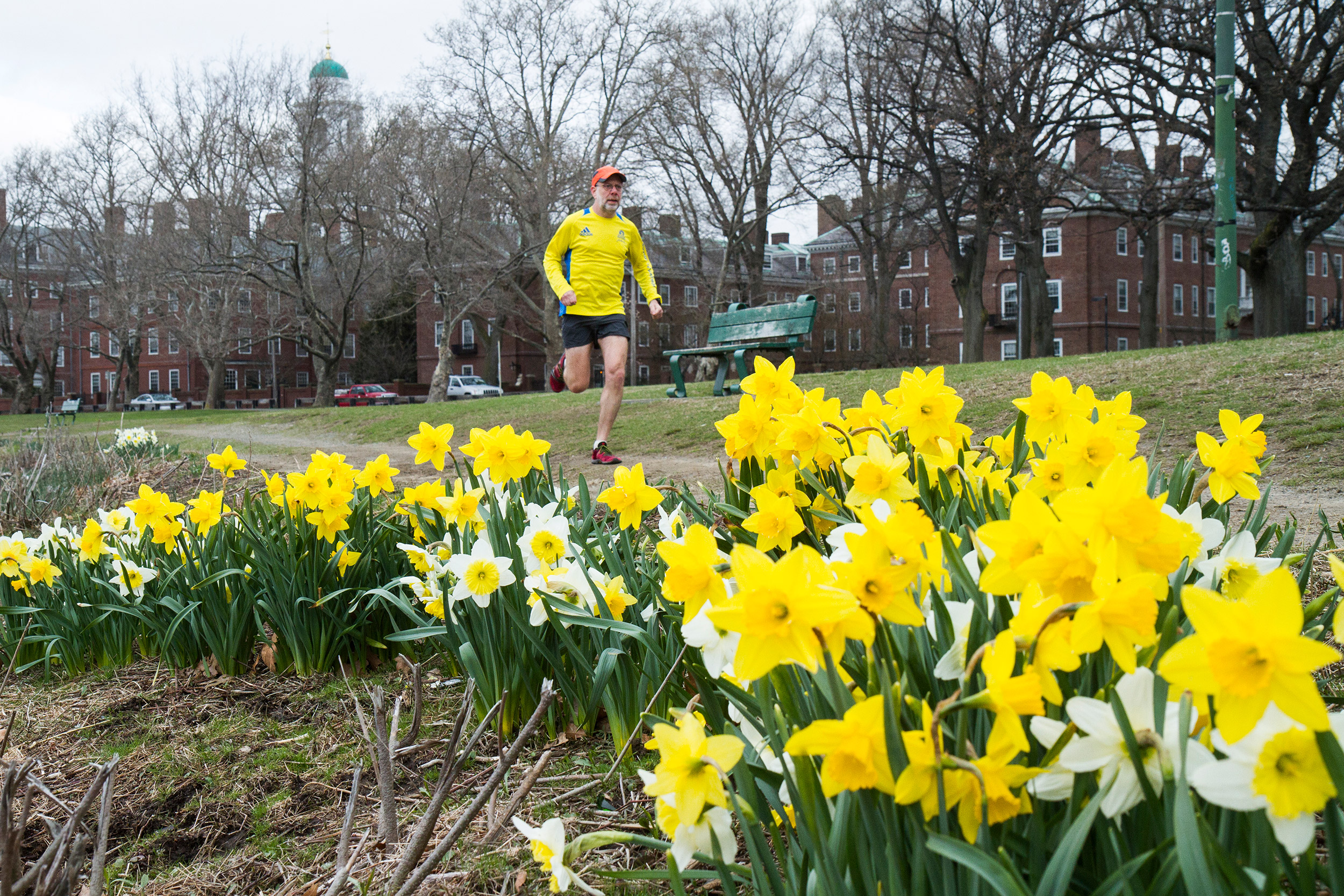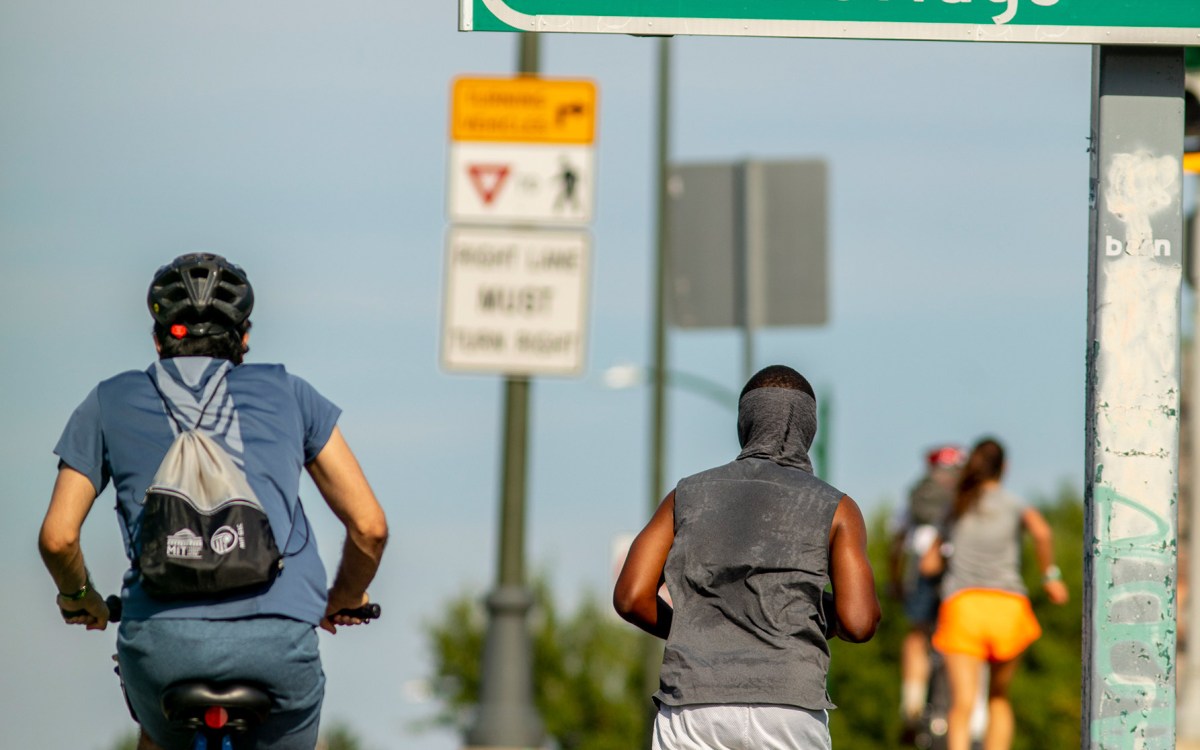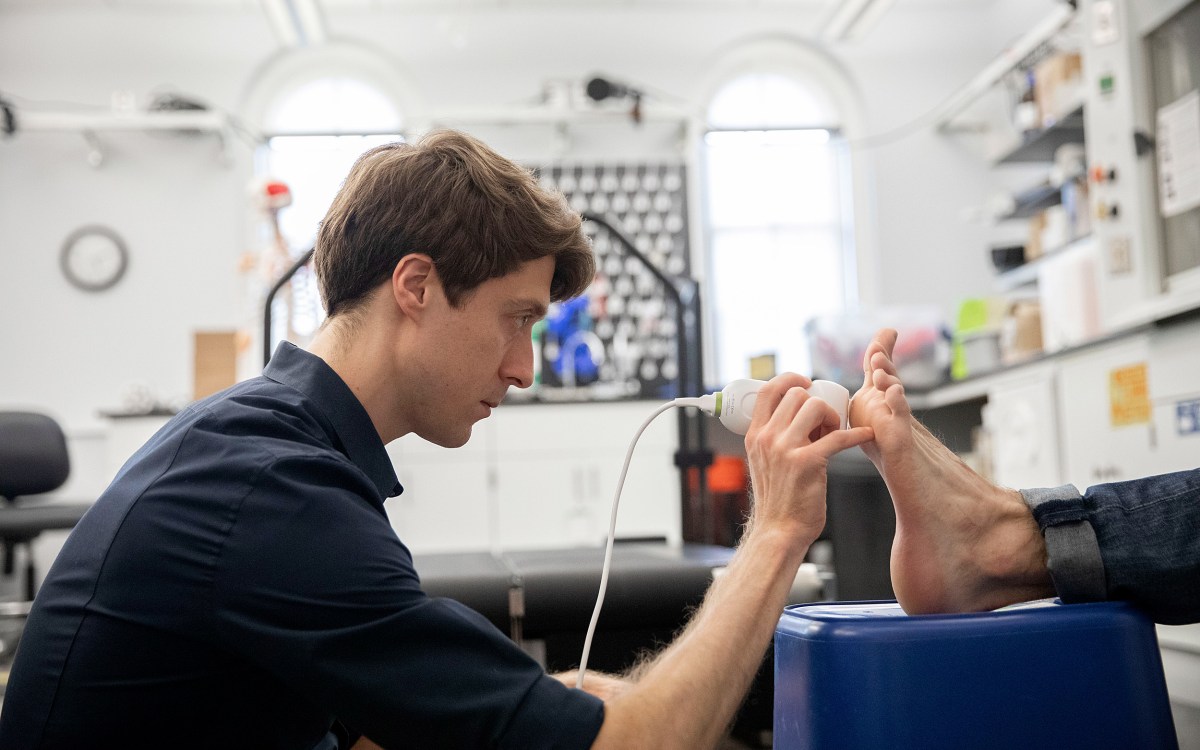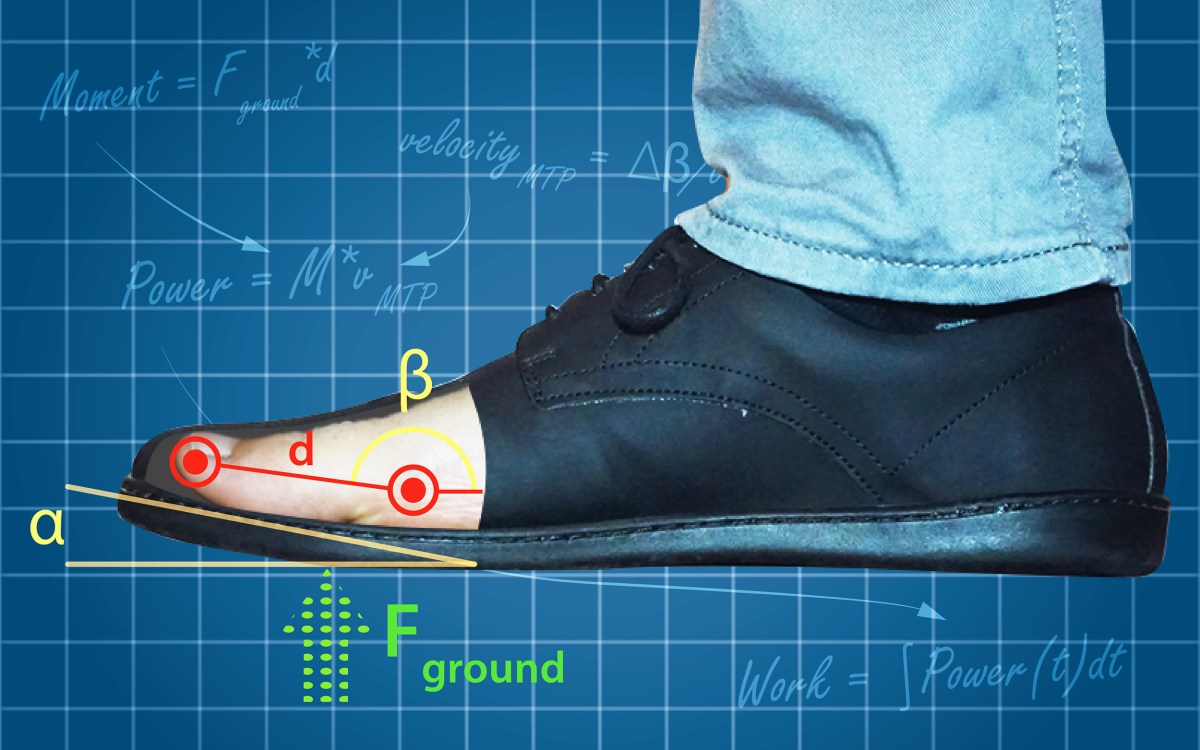
Daniel E. Lieberman: “The least fun exercise experience I ever had was the 2018 Boston Marathon. The only explanation I can give is that I ran for social reasons. Peer pressure is a powerful motivator.“
Jon Chase/Harvard file photo
How to make exercise happen
In his new book, Daniel Lieberman details how emotions can motivate us to move and ignore our evolutionary impulse to just take it easy
Excerpted from “Exercised: Why Something We Never Evolved to Do is Healthy and Rewarding” by Daniel E. Lieberman
Almost all Americans know that exercise promotes health and think they should exercise, yet 50 percent of adults and 73 percent of high school students report they don’t meet minimal levels of physical activity, and 70 percent of adults report they never exercise in their leisure time, according to a 2018 survey by the U.S. government.
Can an evolutionary anthropological approach help us do better?
If we evolved to be physically active because it was either necessary or fun, then isn’t the solution to make exercise necessary and fun?
Everyone copes with the urge to postpone or avoid exercise, so environments that neither require nor facilitate physical activity inevitably promote inactivity. If I have to choose between sitting comfortably in a chair or slogging through a sweaty workout, the chair is almost always more appealing.
To find ways to overcome natural disinclinations to exercise, hundreds of experiments have tested an exhaustive list of interventions designed to entice non-exercisers to get moving. Some studies evaluate the effect of giving people information. This can involve lectures, websites, videos, and pamphlets about how and why to exercise, or providing devices like Fitbits so subjects know how much activity they are getting. Other experiments try to influence people’s behaviors. These studies include having doctors prescribe specific doses of exercise, providing free gym memberships, paying people to exercise, fining them for not exercising, boosting their confidence, or pestering them with phone calls, texts, and emails. Finally, some studies try to encourage people to exercise by altering their environments. Examples include funneling people toward stairs instead of elevators and building sidewalks and bicycle paths. You name it, someone’s tried it.
The good news is that some of these interventions can and do make a difference. A typical example is a 2003 study that enrolled about 900 sedentary New Zealanders between the ages of 40 and 79. Half of them received normal medical care, but the other half were prescribed exercise by doctors, followed up by three phone calls over three months plus quarterly mailings from exercise specialists. After a year, the individuals prescribed exercise averaged 34 minutes of more physical activity per week than the standard care controls.
The bad news is that big successes are the exception rather than the rule. While the extra 34 weekly minutes achieved by those New Zealanders is progress, all that extra effort amounted to only five more minutes of physical activity per day. Comprehensive reviews that have examined hundreds of high-quality studies find that many interventions fail, and those that succeed tend to have only similarly modest effects. There is no surefire way to persuade or coax non-exercisers to exercise substantially.
But didn’t we already know that? If there were an effective, dependable way to transform sedentary people into regular exercisers, it would spread like wildfire. Why aren’t any of these interventions more likely to succeed than our generally ill-fated New Year’s resolutions?
One reason is the complexity and variety of human nature. Even among westernized, industrialized populations, people are dazzlingly diverse in terms of psychology, culture, and biology. Why would a strategy that works on a college student in Los Angeles succeed for an elderly woman in London or a time-stressed parent in the suburbs of Tokyo? Do we really expect the same action plan to work for people who are overweight or thin, insecure or confident, men or women, college graduates or less educated, rich or poor? Indeed, studies that try to figure out who does and doesn’t regularly exercise find few factors common to exercisers apart from some really obvious ones: having a prior history of exercising, being healthy and not overweight, having confidence in the ability to exercise, being more educated, and both liking and wanting to exercise. That list of attributes is about as illuminating as figuring out that people who go to art museums tend to be people who like art.
In my opinion, if we want to promote exercise effectively, we need to grapple with the problem that engaging in voluntary physical activity for the sake of health and fitness is a bizarre, modern, and optional behavior. Like it or not, little voices in our brains help us avoid physical activity when it is neither necessary nor fun. So let’s reconsider both of these qualities from an evolutionary anthropological perspective.
First, necessity. Everyone, including the billion or so humans who regularly don’t get enough exercise, knows that more exercise would be good for them. Many of these non-exercisers feel frustrated or bad about themselves, and annoying exercisers who nag and brag about their efforts rarely improve matters by reminding them to jog, take long walks, go to the gym, and take the stairs. Part of the problem is the distinction between “should” and “need.” I know I should exercise to increase the probability I will be healthier, happier, and live longer with less disability, but there are numerous, legitimate reasons I don’t need to exercise.
In fact, it is patently obvious one can lead a reasonably healthy life without exercise. As the Donald Trumps of the world attest, the 50 percent of Americans who get little to no exercise aren’t doomed to keeling over prematurely. To be sure, insufficient exercise increases their chances of getting heart disease, diabetes, and other illnesses, but most of these diseases tend not to develop until middle age, and then they are often treatable to some degree. Even though more than 50 percent of Americans rarely if ever exercise, the country’s average life expectancy is about 80 years.
Not only is exercise inherently unnecessary, the modern mechanized world has eliminated other formerly necessary forms of non-exercise physical activity. I can easily spend my days without ever having to elevate my heart rate or break a sweat. I can drive to work, take an elevator to my office floor, spend the day in a chair, buy food, make meals, and wash clothes with little effort.
In addition to being unnecessary, exercise takes precious time, keeping us from other, higher-priority activities. Many people have to commute long distances to work to sedentary office jobs fixed in terms of hours, and they have other time-consuming obligations including child care and elder care. Paradoxically, for the first time in history, wealthier people get more physical activity than the working poor. When free time is scarce, optional activities like exercise are relegated to weekends, and by then a week’s worth of accumulated fatigue can make it hard to muster the energy. When people are asked what keeps them from exercising, they almost always list time as a main barrier.
Which brings up fun. Lack of time can be stressful, but even the busiest people I know manage to find time to do things they enjoy or find rewarding like watch TV, surf the web, or gossip. I suspect millions of non-exercisers would succeed in making exercise a greater priority if they found it more enjoyable, but for them exercise is often emotionally unrewarding and physically unpleasant. These negative reactions are probably ancient adaptations. Like most organisms, we have been selected to enjoy and desire sex, eating, and other behaviors that benefit our reproductive success and to dislike behaviors like fasting that don’t help us have more babies. If our Stone Age ancestors found unnecessary physical activities like optional five-mile jogs unpleasant, they would have avoided squandering limited energy that could have been allocated toward reproduction.
That may be a “just-so story,” but few would disagree that non-exercisers are not entirely irrational because exercise is a modern behavior that is by definition unnecessary and often unpleasant. For many, it is also inconvenient and inaccessible. If we can’t make exercise necessary and fun, perhaps we can make it more necessary and more fun.
The least fun exercise experience I ever had was the 2018 Boston Marathon. Boston weather at the end of April is sometimes nice, sometimes chilly, sometimes warm, or sometimes rainy, but the nor’easter that battered Boston that day was unusually brutal. By 10:00 a.m., when the race began, it had been pouring steadily for hours, the temperature was a few degrees above freezing, and there was a fierce headwind that gusted up to 35 miles per hour.
The next 26.2 miles were horrid. My primary urge on crossing the finish line was to crawl into bed as fast as possible to warm up, which is exactly what I did.
Over the next few days as I recovered physically and mentally, I thought about why I and 25,000 other lunatics ran through that storm. If my goal was simply to run 26.2 miles, I could have waited until the next day and enjoyed nearly perfect weather. The only explanation I can give is that I ran for social reasons. Like a soldier in battle, I wasn’t alone but instead part of a collective doing something difficult together. Peer pressure is a powerful motivator.
And therein lies an important lesson about why we exercise. Because exercise by definition isn’t necessary, we mostly do it for emotional or physical rewards, and on that horrid April day in 2018, the only rewards were emotional — all stemming from the event’s social nature. For the last few million years humans rarely engaged in hours of moderate to vigorous exertion alone. When hunter-gatherer women forage, they usually go in groups, gossiping and enjoying each other’s company as they go. Men often travel in parties of two or more when they hunt or collect honey. Farmers work in teams when they plow, plant, weed, and harvest. So when friends or CrossFitters work out together in the gym, teams play a friendly game of soccer, or several people chat for mile after mile as they walk or run, they are continuing a long tradition of social physical activity.
I think there is a deeper evolutionary explanation for why almost every book, website, article, and podcast on how to encourage exercise advises doing it in a group. Humans are intensely social creatures, and more than any other species we cooperate with unrelated strangers. We used to hunt and gather together, and we still share food, shelter, and other resources; we help raise one another’s children; we fight together; we play together. As a result, we have been selected to enjoy doing activities in groups, to assist one another, and to care what others think of us. Physical activities like exercise are no exception.
Of course, exercise is also sometimes enjoyable without socializing. A solitary walk or run can be meditative, and working out while listening to podcasts or watching TV in the gym (a distinctly modern phenomenon) can be diverting. But for most people exercising with others is more emotionally rewarding. For this reason, sports, games, dancing, and other types of play are among the most popular social activities, and regular exercisers often belong to clubs, teams, and gyms.
Exercise can also make us feel good, which helps make it enjoyable. After a good workout I feel simultaneously alert, euphoric, tranquil, and free from pain — not unlike taking an opioid. Actually, natural selection did adopt this drug-pushing strategy by having our brains manufacture an impressive cocktail of mood-altering pharmaceuticals in response to physical activity. The four most important of these endogenous drugs are dopamine, serotonin, endorphins, and endocannabinoids, but in a classic evolutionary design flaw these primarily reward people who are already physically active.
While these and other chemicals released by exercise help us exercise, their drawback is they mostly function through virtuous cycles. When we do something like walk or run six miles, we produce dopamine, serotonin, and other chemicals that make us feel good and more likely to do it again. When we are sedentary, however, a vicious cycle ensues. As we become more out of shape, our brains become less able to reward us for exercising. It’s a classic mismatch: Because few of our ancestors were physically inactive and unfit, the brain’s hedonic response to exercise never evolved to work well in persistently sedentary individuals.
So what should we as a society and you and I as individuals do? How can we make exercise more fun and rewarding, especially if we are out of shape?
Commonly recommended, sensible methods to make exercise more fun (or less unfun) include:
- Be social: exercise with friends, a group, or a good, qualified trainer.
- Entertain yourself: listen to music, podcasts, or books, or watch a movie.
- Exercise outside in a beautiful environment.
- Dance or play sports and games.
- Because variety is enjoyable, experiment and mix things up.
- Choose realistic goals based on time, not performance, so you don’t set yourself up for disappointment.
- Reward yourself for exercising.
Second, if you are struggling to exercise, it is useful to remember how and why exercising takes time to become enjoyable or less unpleasant. Because we never evolved to be inactive and out of shape, the adaptations that make physical activity feel rewarding and become a habit develop only after the several months of effort it takes to improve fitness. Slowly and gradually, exercise switches from being a negative feedback loop in which discomfort and lack of reward inhibit us from exercising again to being a positive feedback loop in which exercise becomes satisfying.
So, yes, exercise can become more rewarding and fun. But let’s not deceive ourselves or others. No matter what we do to make exercise more enjoyable, the prospect of exercising usually seems less desirable and less comfortable than staying put. To overcome my inertia, I usually have to figure out how to make it seem necessary. The most acceptable way to do that is to find ways of coercing ourselves through agreed-upon nudges and shoves.
Nudges influence our behaviors without force, without limiting our choices, and without shifting our economic incentives. Typical nudges involve changing default options (like opting out of being an organ donor instead of opting in) or small changes to the environment (like placing healthier foods prominently at the front of the salad bar). Predictably, many would-be exercisers are advised to try various nudges to make the act of choosing exercise more of a default, simpler, and less of a hassle. Examples include:
- Put out your exercise clothes the night before you exercise so you wear them first thing in the morning and are ready to go (alternatively, sleep in your exercise clothes).
- Schedule exercise so it becomes a default.
- Use a friend or an app to remind you to exercise.
- Make the stairs more convenient than taking the elevator or escalator.
Shoves are more drastic forms of self-coercion. They are unobjectionable because you do them to yourself voluntarily, but they are more forceful than nudges. Examples include:
- Scheduling exercise with a friend or a group beforehand. You then become socially obligated to show up.
- Exercising in a group such as a CrossFit class. If you waver, the group will keep you going.
- Signing a commitment contract with an organization like StickK.com that sends money to an organization you dislike if you don’t exercise (a stick) or to one you like if you do (a carrot).
- Signing up (and paying) for a race or some other event that requires you to train.
- Posting your exercise online so others see what you are (or are not) doing.
- Designating a friend, a relative, or someone you admire or fear as a referee to check up on your progress.
Note that all of these methods share one essential quality: They involve social commitment. Whether you plan to exercise with a friend, a yoga class, a team, a platoon of walkers and runners in a 5K event or report your exercise accomplishments (or lack thereof) online, you are pledging to others that you will be physically active. In return you get both carrots in the form of encouragement and support and sticks in the form of shame or disapprobation. In short, we all need nudges.
“Exercised” by Daniel E. Lieberman is published by Pantheon Books, an imprint of the Knopf Doubleday Publishing Group, a division of Penguin Random House LLC. Copyright (c) 2020 by Daniel E. Lieberman.







